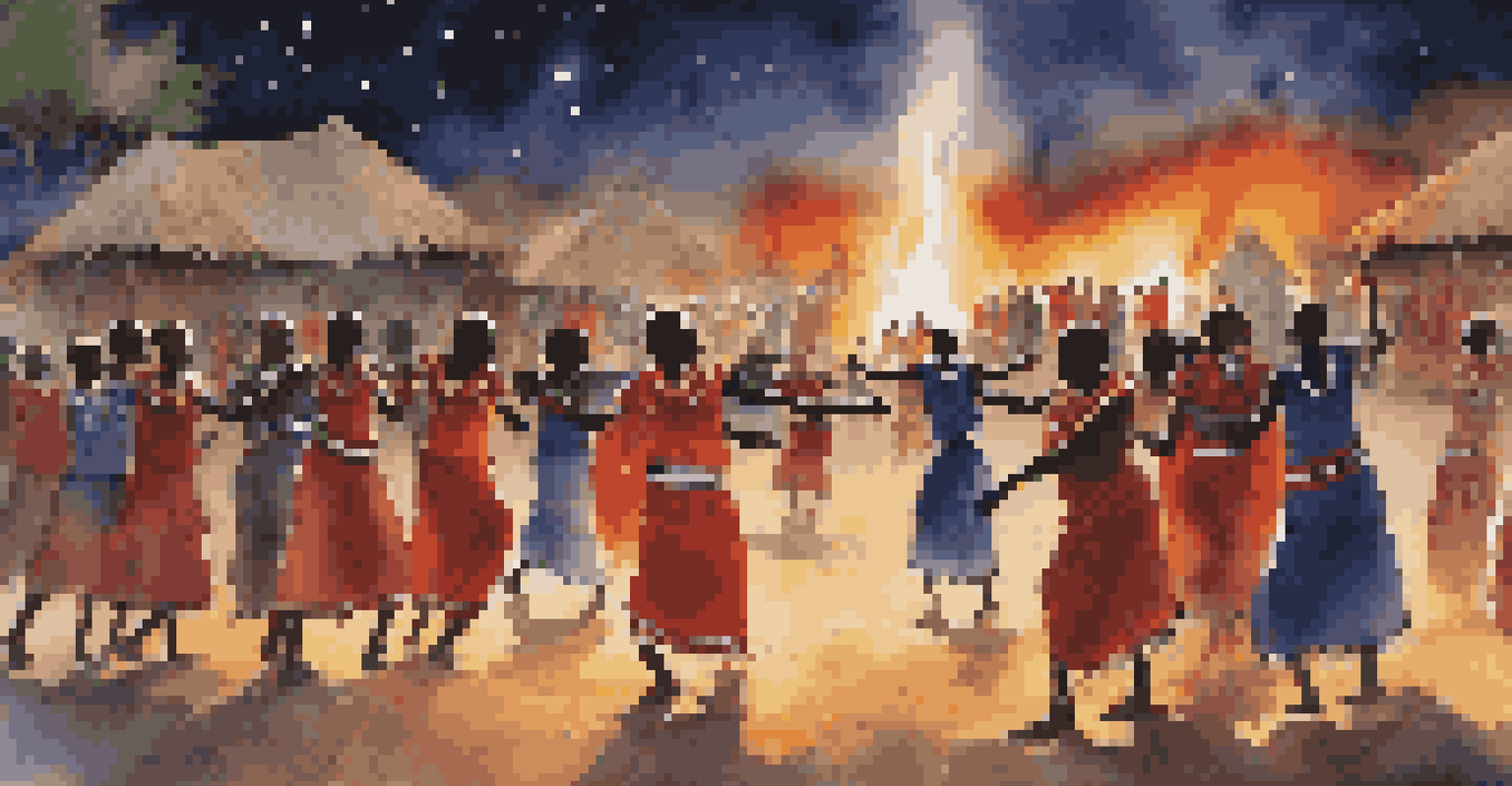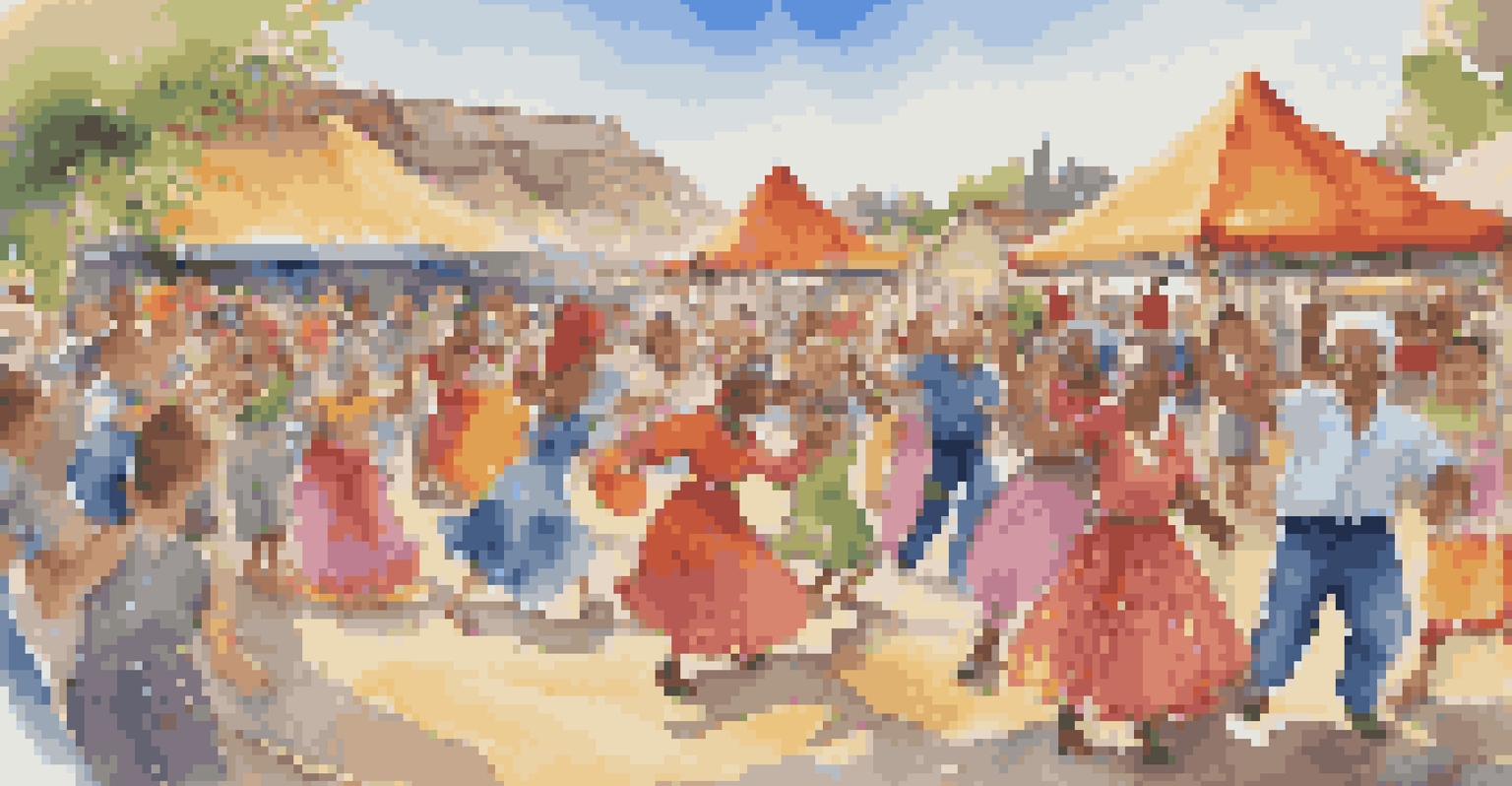The Cultural Significance of Dance in African Societies

Dance as a Reflection of Identity in African Cultures
Dance in African societies is a profound expression of cultural identity. Each movement, rhythm, and style tells a story, reflecting the history and values of the community. For instance, the vibrant movements of traditional Zulu dance not only entertain but also convey the rich heritage of the Zulu people.
Dance is the hidden language of the soul.
Moreover, dance serves as a way to preserve cultural narratives, passing down stories from generation to generation. In this way, participants learn about their ancestors and the significance of their traditions. It’s like a living history book, where every performance is a chapter in the community’s ongoing tale.
This connection between dance and identity fosters a sense of belonging among community members. When individuals participate in these dance forms, they are not just performing; they are reinforcing their ties to their culture and each other, creating a strong communal bond.
Rituals and Ceremonies: Dance as a Spiritual Practice
In many African societies, dance is an integral part of rituals and ceremonies, acting as a bridge between the physical and spiritual worlds. Whether celebrating a birth, a wedding, or a rite of passage, dance elevates the significance of these events. For example, the Maasai people of Kenya and Tanzania perform traditional dances during ceremonies to honor their gods and ancestors.

These dances are often accompanied by specific songs and drumming that enhance the spiritual experience. The rhythmic beats and movements create a collective energy, allowing participants to connect on a deeper level with their spirituality. It’s a fascinating interplay where body and soul unite in celebration.
Dance Reflects Cultural Identity
Dance in African societies serves as a profound expression of cultural identity, telling stories and preserving traditions.
Additionally, dance can be a form of healing, as it is sometimes used to invoke blessings or seek guidance from the ancestors. This highlights the multifaceted role dance plays in African cultures, serving not just as entertainment but as a vital component of spiritual life.
Social Cohesion: Dance as a Unifying Force
Dance fosters social cohesion by bringing people together in a shared experience. In many communities, group dances are a staple at social gatherings, encouraging participation from all ages. This collective involvement creates a sense of unity, as everyone moves in harmony with one another, celebrating their shared identity.
The dance is a poem of which each movement is a word.
For instance, community dances during harvest festivals allow villagers to come together, celebrate their hard work, and strengthen their communal bonds. The shared joy of dancing reinforces social ties and creates lasting memories that further entwine individuals with their community.
Moreover, these communal dance events often serve as platforms for dialogue and interaction, allowing people to express their thoughts and feelings. In this way, dance transcends mere entertainment, becoming a vital tool for social interaction and community building.
Dance as a Medium of Storytelling and Communication
Dance in African societies often serves as a powerful medium for storytelling. Each dance has its own narrative, conveying messages about love, war, life challenges, and triumphs. For instance, the Adamu Orisha Play from the Yoruba culture combines music, dance, and storytelling to narrate the adventures of deities, engaging audiences with rich, cultural tales.
Through gestures, expressions, and movements, dancers communicate emotions and experiences that words sometimes cannot convey. This form of non-verbal communication allows for a unique connection between the performer and the audience, fostering empathy and understanding.
Dance as a Spiritual Practice
In many African cultures, dance is integral to rituals, bridging the physical and spiritual worlds during significant life events.
Additionally, dance can be a way to address societal issues, such as injustice or inequality. By embodying these themes through movement, dancers can spark conversations and provoke thought within their communities, illustrating the profound impact dance can have beyond mere entertainment.
The Role of Dance in African Economic Activities
Dance also plays a significant role in the economic activities of African societies. Many communities engage in dance as a source of income, whether through performances at cultural events, festivals, or tourism. Traditional dance troupes often showcase their skills to attract visitors, allowing them to share their culture while also supporting their livelihoods.
Moreover, dance festivals can draw large crowds, creating opportunities for local vendors and artisans to sell their crafts. This economic boost can be vital for communities, as it promotes cultural heritage while stimulating local economies.
In this way, dance not only enriches cultural life but also serves as a foundation for economic sustainability. By integrating dance into economic activities, communities can preserve their traditions while fostering growth and development.
Modern Influences and the Evolution of African Dance
As global influences permeate traditional practices, African dance is evolving, blending contemporary styles with age-old traditions. This fusion creates new forms of expression and allows younger generations to connect with their heritage while also embracing modernity. For instance, genres like Afrobeats incorporate traditional dance moves, creating a vibrant culture that resonates with both local and international audiences.
Social media platforms have also played a significant role in this evolution, as they provide a space for dancers to showcase their skills and reach wider audiences. Viral dance challenges often draw from traditional movements, introducing them to a new generation and sparking interest in cultural roots.
Dance Fosters Social Cohesion
Community dances create shared experiences that strengthen bonds and promote unity among participants of all ages.
While some purists may express concern over the commercialization of traditional dance, this evolution can be seen as an opportunity for cultural exchange and dialogue. By adapting and innovating, African dance can thrive in a globalized world, ensuring its relevance for future generations.
Conclusion: Embracing the Spirit of African Dance Culture
The cultural significance of dance in African societies is profound and multifaceted. It reflects identity, fosters social cohesion, serves as a medium for storytelling, and even plays a role in economic activities. By celebrating dance, communities not only honor their past but also embrace the future.
As we continue to witness the evolution of African dance, it is essential to appreciate its roots while supporting its growth. This balance allows for a richer cultural tapestry that honors traditions while welcoming innovation.

Ultimately, dance is more than just movement; it is an embodiment of life, spirit, and community. By understanding and appreciating the cultural significance of dance, we can foster a deeper connection to the diverse and vibrant societies that shape our world.